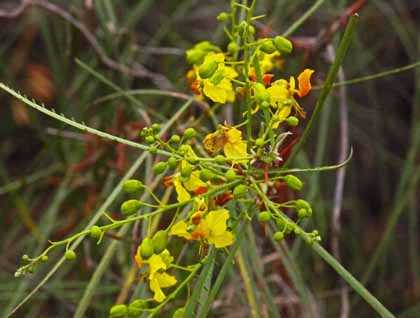Here we are again—ready to explore more of this magical place that is the Galápagos. At 6:30 a.m. we jumped onto the green beach of Punta Cormorant. The sand is green because of the amount of olivine present; olivine is a crystal very common in basalt formations. As soon as we started walking, we saw a big brackish water lagoon with about 10 greater flamingos. Flamingos are not very common in Galápagos, but they are one of the most beautiful birds. Here they are very pink because of the amount of pink brine shrimp in the water.
At this part of the year the vegetation looks very dry. Nevertheless, some of these plants stay green by taking in moisture from morning dew. Animals evolve in isolation and plants do too. At the end of the trail, there is a small white coral sandy beach, where we saw tracks left by marine turtles that climb onto the dunes at night to lay their eggs. Some stingrays came close to shore and it was easy to see them. Up in the sky, frigates and pelicans were ready to catch any food available to start the day.
After our very early exploration, we headed back to the ship. That was when nature offered us a wonderful surprise. Our expedition leader Lynn Fowler announced by radio that many dolphins were surrounding our ship! Indeed, there were about 200 bottlenose dolphins swimming and leaping close to our Zodiacs. We all yelled in excitement, especially the youngest explorers.
Later, after breakfast, we took Zodiac rides around Champion Islet. The goal was to find some Charles mockingbirds, a bird in danger of extinction and one of the four species that Charles Darwin collected when he visited the islands in 1835. We had a lot of fun circumnavigating this islet. We found two mockingbirds and many red-billed tropic birds nesting along the cliff. Then we came back to our ship to suit up and grab our snorkeling gear to explore the marine ecosystems that are unique to this archipelago. Champion Islet is considered one of the best areas for snorkeling because of the amazing the quantity of marine life. Big schools of king angel fish, salemas, grunts, Moorish idols, razors, parrot fish, sea lions, turtles, and many kinds of sea stars.
We had lunch to recover our energy. During this time, the kids came to the lounge to paint and decorate some postcards, which we would need this afternoon when we visit Post Office Bay. The oldest post office in South America, it was established there in 1793 by whalers that visited the islands and left their mark on this bay.
At 3:45 p.m. we disembarked at this historic place, where many human stories are told. Floreana is known as the island of mysteries and tragedies. It was here that the first Ecuador president, Juan Jose Flores, sent people to claim Galápagos as soon as Ecuador became a country in 1832. We dipped our hands into the old post office barrel to collect some letters or post cards and checked the addresses. By tradition, if a traveler finds an address that’s close to home, the traveler is supposed to hand-deliver it when he or she returns. This was how the old mail system worked for the whalers and how it works nowadays with all our visitors.
Our short visit ended and we motored around several islets in front of Post Office Bay looking for turtles, seabirds, and herons. The sun descended quickly and we knew it was time to finish our day. We saw so many things that we will form memories we’ll have forever. The Galápagos is an amazing place that changes people’s lives. I am glad to be part of it.







